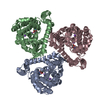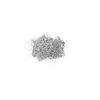[English] 日本語
 Yorodumi
Yorodumi- EMDB-27007: Human Excitatory excitatory amino acid transporter 3 (EAAT3) prot... -
+ Open data
Open data
- Basic information
Basic information
| Entry |  | |||||||||
|---|---|---|---|---|---|---|---|---|---|---|
| Title | Human Excitatory excitatory amino acid transporter 3 (EAAT3) protomer at in an intermediate outward facing sodium-bound state | |||||||||
 Map data Map data | human Excitatory amino acid transporter3 protomer at intermediate outward facing (iOFS) sodium bound state | |||||||||
 Sample Sample |
| |||||||||
 Keywords Keywords | TRANSPORT PROTEIN | |||||||||
| Function / homology |  Function and homology information Function and homology informationD-aspartate transmembrane transport / regulation of protein targeting to membrane / D-aspartate transmembrane transporter activity / Defective SLC1A1 is implicated in schizophrenia 18 (SCZD18) and dicarboxylic aminoaciduria (DCBXA) / distal dendrite / cysteine transport / cysteine transmembrane transporter activity / neurotransmitter receptor transport to plasma membrane / high-affinity L-glutamate transmembrane transporter activity / glutamate:sodium symporter activity ...D-aspartate transmembrane transport / regulation of protein targeting to membrane / D-aspartate transmembrane transporter activity / Defective SLC1A1 is implicated in schizophrenia 18 (SCZD18) and dicarboxylic aminoaciduria (DCBXA) / distal dendrite / cysteine transport / cysteine transmembrane transporter activity / neurotransmitter receptor transport to plasma membrane / high-affinity L-glutamate transmembrane transporter activity / glutamate:sodium symporter activity / response to decreased oxygen levels / L-glutamate import / cellular response to mercury ion / Transport of inorganic cations/anions and amino acids/oligopeptides / retina layer formation / L-glutamate transmembrane transporter activity / L-glutamate transmembrane transport / glutathione biosynthetic process / D-aspartate import across plasma membrane / L-aspartate transmembrane transport / cellular response to ammonium ion / righting reflex / zinc ion transmembrane transport / cellular response to bisphenol A / L-aspartate transmembrane transporter activity / grooming behavior / intracellular glutamate homeostasis / L-aspartate import across plasma membrane / Glutamate Neurotransmitter Release Cycle / proximal dendrite / monoatomic anion channel activity / L-glutamate import across plasma membrane / apical dendrite / transepithelial transport / response to anesthetic / conditioned place preference / intracellular zinc ion homeostasis / cellular response to cocaine / blood vessel morphogenesis / chloride transmembrane transporter activity / motor neuron apoptotic process / G protein-coupled dopamine receptor signaling pathway / motor behavior / response to morphine / glutamate receptor signaling pathway / glutamate binding / neurotransmitter transport / superoxide metabolic process / maintenance of blood-brain barrier / heart contraction / perisynaptic space / dopamine metabolic process / : / adult behavior / asymmetric synapse / glial cell projection / response to axon injury / behavioral fear response / synaptic cleft / postsynaptic modulation of chemical synaptic transmission / transport across blood-brain barrier / positive regulation of heart rate / monoatomic ion transport / neurogenesis / axon terminus / response to amphetamine / chloride transmembrane transport / dendritic shaft / cell periphery / locomotory behavior / synapse organization / cytokine-mediated signaling pathway / brain development / Schaffer collateral - CA1 synapse / memory / long-term synaptic potentiation / recycling endosome membrane / late endosome membrane / presynapse / cellular response to oxidative stress / early endosome membrane / gene expression / chemical synaptic transmission / dendritic spine / perikaryon / negative regulation of neuron apoptotic process / apical plasma membrane / membrane raft / response to xenobiotic stimulus / axon / external side of plasma membrane / neuronal cell body / dendrite / endoplasmic reticulum / extracellular exosome / metal ion binding / identical protein binding / membrane / plasma membrane Similarity search - Function | |||||||||
| Biological species |  Homo sapiens (human) Homo sapiens (human) | |||||||||
| Method | single particle reconstruction / cryo EM / Resolution: 3.04 Å | |||||||||
 Authors Authors | Qiu B / Boudker O | |||||||||
| Funding support |  United States, 1 items United States, 1 items
| |||||||||
 Citation Citation |  Journal: Nat Commun / Year: 2023 Journal: Nat Commun / Year: 2023Title: Symport and antiport mechanisms of human glutamate transporters. Authors: Biao Qiu / Olga Boudker /  Abstract: Excitatory amino acid transporters (EAATs) uptake glutamate into glial cells and neurons. EAATs achieve million-fold transmitter gradients by symporting it with three sodium ions and a proton, and ...Excitatory amino acid transporters (EAATs) uptake glutamate into glial cells and neurons. EAATs achieve million-fold transmitter gradients by symporting it with three sodium ions and a proton, and countertransporting a potassium ion via an elevator mechanism. Despite the availability of structures, the symport and antiport mechanisms still need to be clarified. We report high-resolution cryo-EM structures of human EAAT3 bound to the neurotransmitter glutamate with symported ions, potassium ions, sodium ions alone, or without ligands. We show that an evolutionarily conserved occluded translocation intermediate has a dramatically higher affinity for the neurotransmitter and the countertransported potassium ion than outward- or inward-facing transporters and plays a crucial role in ion coupling. We propose a comprehensive ion coupling mechanism involving a choreographed interplay between bound solutes, conformations of conserved amino acid motifs, and movements of the gating hairpin and the substrate-binding domain. | |||||||||
| History |
|
- Structure visualization
Structure visualization
| Supplemental images |
|---|
- Downloads & links
Downloads & links
-EMDB archive
| Map data |  emd_27007.map.gz emd_27007.map.gz | 95.9 MB |  EMDB map data format EMDB map data format | |
|---|---|---|---|---|
| Header (meta data) |  emd-27007-v30.xml emd-27007-v30.xml emd-27007.xml emd-27007.xml | 18.1 KB 18.1 KB | Display Display |  EMDB header EMDB header |
| FSC (resolution estimation) |  emd_27007_fsc.xml emd_27007_fsc.xml | 10.7 KB | Display |  FSC data file FSC data file |
| Images |  emd_27007.png emd_27007.png | 34.9 KB | ||
| Filedesc metadata |  emd-27007.cif.gz emd-27007.cif.gz | 6.1 KB | ||
| Others |  emd_27007_half_map_1.map.gz emd_27007_half_map_1.map.gz emd_27007_half_map_2.map.gz emd_27007_half_map_2.map.gz | 80.4 MB 80.9 MB | ||
| Archive directory |  http://ftp.pdbj.org/pub/emdb/structures/EMD-27007 http://ftp.pdbj.org/pub/emdb/structures/EMD-27007 ftp://ftp.pdbj.org/pub/emdb/structures/EMD-27007 ftp://ftp.pdbj.org/pub/emdb/structures/EMD-27007 | HTTPS FTP |
-Validation report
| Summary document |  emd_27007_validation.pdf.gz emd_27007_validation.pdf.gz | 925 KB | Display |  EMDB validaton report EMDB validaton report |
|---|---|---|---|---|
| Full document |  emd_27007_full_validation.pdf.gz emd_27007_full_validation.pdf.gz | 924.6 KB | Display | |
| Data in XML |  emd_27007_validation.xml.gz emd_27007_validation.xml.gz | 17.7 KB | Display | |
| Data in CIF |  emd_27007_validation.cif.gz emd_27007_validation.cif.gz | 23.2 KB | Display | |
| Arichive directory |  https://ftp.pdbj.org/pub/emdb/validation_reports/EMD-27007 https://ftp.pdbj.org/pub/emdb/validation_reports/EMD-27007 ftp://ftp.pdbj.org/pub/emdb/validation_reports/EMD-27007 ftp://ftp.pdbj.org/pub/emdb/validation_reports/EMD-27007 | HTTPS FTP |
-Related structure data
| Related structure data |  8cv3MC  8ctcC  8ctdC  8cuaC  8cudC  8cuiC  8cujC  8cv2C M: atomic model generated by this map C: citing same article ( |
|---|---|
| Similar structure data | Similarity search - Function & homology  F&H Search F&H Search |
- Links
Links
| EMDB pages |  EMDB (EBI/PDBe) / EMDB (EBI/PDBe) /  EMDataResource EMDataResource |
|---|---|
| Related items in Molecule of the Month |
- Map
Map
| File |  Download / File: emd_27007.map.gz / Format: CCP4 / Size: 103 MB / Type: IMAGE STORED AS FLOATING POINT NUMBER (4 BYTES) Download / File: emd_27007.map.gz / Format: CCP4 / Size: 103 MB / Type: IMAGE STORED AS FLOATING POINT NUMBER (4 BYTES) | ||||||||||||||||||||||||||||||||||||
|---|---|---|---|---|---|---|---|---|---|---|---|---|---|---|---|---|---|---|---|---|---|---|---|---|---|---|---|---|---|---|---|---|---|---|---|---|---|
| Annotation | human Excitatory amino acid transporter3 protomer at intermediate outward facing (iOFS) sodium bound state | ||||||||||||||||||||||||||||||||||||
| Projections & slices | Image control
Images are generated by Spider. | ||||||||||||||||||||||||||||||||||||
| Voxel size | X=Y=Z: 0.852 Å | ||||||||||||||||||||||||||||||||||||
| Density |
| ||||||||||||||||||||||||||||||||||||
| Symmetry | Space group: 1 | ||||||||||||||||||||||||||||||||||||
| Details | EMDB XML:
|
-Supplemental data
-Half map: Half Map 1
| File | emd_27007_half_map_1.map | ||||||||||||
|---|---|---|---|---|---|---|---|---|---|---|---|---|---|
| Annotation | Half Map 1 | ||||||||||||
| Projections & Slices |
| ||||||||||||
| Density Histograms |
-Half map: Half Map 2
| File | emd_27007_half_map_2.map | ||||||||||||
|---|---|---|---|---|---|---|---|---|---|---|---|---|---|
| Annotation | Half Map 2 | ||||||||||||
| Projections & Slices |
| ||||||||||||
| Density Histograms |
- Sample components
Sample components
-Entire : human Excitatory amino acid transporter 3 at outward facing (OFS)...
| Entire | Name: human Excitatory amino acid transporter 3 at outward facing (OFS) sodium bound state |
|---|---|
| Components |
|
-Supramolecule #1: human Excitatory amino acid transporter 3 at outward facing (OFS)...
| Supramolecule | Name: human Excitatory amino acid transporter 3 at outward facing (OFS) sodium bound state type: complex / ID: 1 / Parent: 0 / Macromolecule list: #1 |
|---|---|
| Source (natural) | Organism:  Homo sapiens (human) Homo sapiens (human) |
-Supramolecule #2: human Excitatory amino acid transporter 3 at outward facing (OFS)...
| Supramolecule | Name: human Excitatory amino acid transporter 3 at outward facing (OFS) sodium bound state type: complex / ID: 2 / Parent: 1 / Macromolecule list: #1 |
|---|---|
| Source (natural) | Organism:  Homo sapiens (human) Homo sapiens (human) |
-Macromolecule #1: Excitatory amino acid transporter 3
| Macromolecule | Name: Excitatory amino acid transporter 3 / type: protein_or_peptide / ID: 1 / Number of copies: 1 / Enantiomer: LEVO |
|---|---|
| Source (natural) | Organism:  Homo sapiens (human) Homo sapiens (human) |
| Molecular weight | Theoretical: 57.120863 KDa |
| Recombinant expression | Organism:  Homo sapiens (human) Homo sapiens (human) |
| Sequence | String: GPMGKPARKG AEWKRFLKNN WVLLSTVAAV VLGITTGVLV REHSNLSTLE KFYFAFPGEI LMRMLKLIIL PLIISSMITG VAALDSNVS GKIGLRAVVY YFATTLIAVI LGIVLVVSIK PGVTQKVGEI ARTGSTPEVS TVDAMLDLIR NMFPENLVQA A FQQYKTKR ...String: GPMGKPARKG AEWKRFLKNN WVLLSTVAAV VLGITTGVLV REHSNLSTLE KFYFAFPGEI LMRMLKLIIL PLIISSMITG VAALDSNVS GKIGLRAVVY YFATTLIAVI LGIVLVVSIK PGVTQKVGEI ARTGSTPEVS TVDAMLDLIR NMFPENLVQA A FQQYKTKR EEVKPPSDPE MTMTEESFTA VMTTAISKTK TKEYKIVGMY SDGINVLGLI VFALVFGLVI GKMGEKGQIL VD FFNALSD ATMKIVQIIM WYMPLGILFL IAGCIIEVED WEIFRKLGLY MATVLTGLAI HSIVILPLIY FIVVRKNPFR FAM GMAQAL LTALMISSSS ATLPVTFRCA EENNQVDKRI TRFVLPVGAT INMDGTALYE AVAAVFIAQL NDLDLGIGQI ITIS ITATS ASIGAAGVPQ AGLVTMVIVL SAVGLPAEDV TLIIAVDCLL DRFRTMVNVL GDAFGTGIVE KLSKKELEQM DVSSE VNIV NPFALESTIL DNEDSDTKKS YVNGGFAVDK SDTISFTQTS QF UniProtKB: Excitatory amino acid transporter 3 |
-Macromolecule #2: SODIUM ION
| Macromolecule | Name: SODIUM ION / type: ligand / ID: 2 / Number of copies: 2 |
|---|---|
| Molecular weight | Theoretical: 22.99 Da |
-Experimental details
-Structure determination
| Method | cryo EM |
|---|---|
 Processing Processing | single particle reconstruction |
| Aggregation state | particle |
- Sample preparation
Sample preparation
| Concentration | 4.1 mg/mL | ||||||||||||
|---|---|---|---|---|---|---|---|---|---|---|---|---|---|
| Buffer | pH: 7.4 Component:
Details: Tris is used to adjust pH. Not list here because the concentration is unknown | ||||||||||||
| Grid | Model: Quantifoil R1.2/1.3 / Material: GOLD / Mesh: 300 / Support film - Material: CARBON / Support film - topology: HOLEY | ||||||||||||
| Vitrification | Cryogen name: ETHANE / Chamber humidity: 100 % / Chamber temperature: 277 K / Instrument: FEI VITROBOT MARK IV / Details: blot 3s. | ||||||||||||
| Details | the sample was monodisperse |
- Electron microscopy
Electron microscopy
| Microscope | FEI TITAN KRIOS |
|---|---|
| Image recording | Film or detector model: GATAN K3 BIOQUANTUM (6k x 4k) / Average electron dose: 57.52 e/Å2 |
| Electron beam | Acceleration voltage: 300 kV / Electron source:  FIELD EMISSION GUN FIELD EMISSION GUN |
| Electron optics | C2 aperture diameter: 100.0 µm / Illumination mode: FLOOD BEAM / Imaging mode: BRIGHT FIELD / Nominal defocus max: 2.0 µm / Nominal defocus min: 1.3 µm / Nominal magnification: 105000 |
| Sample stage | Specimen holder model: FEI TITAN KRIOS AUTOGRID HOLDER / Cooling holder cryogen: NITROGEN |
| Experimental equipment |  Model: Titan Krios / Image courtesy: FEI Company |
 Movie
Movie Controller
Controller












 Z (Sec.)
Z (Sec.) Y (Row.)
Y (Row.) X (Col.)
X (Col.)






































